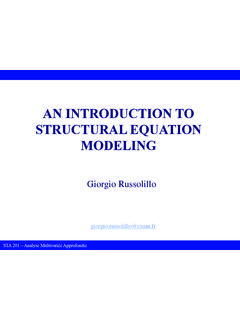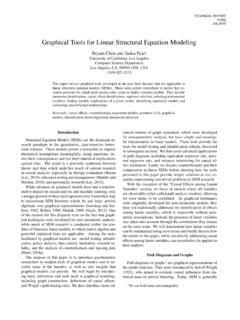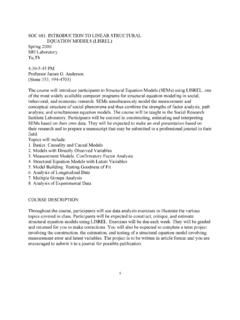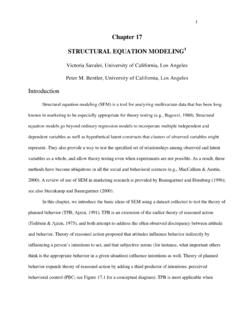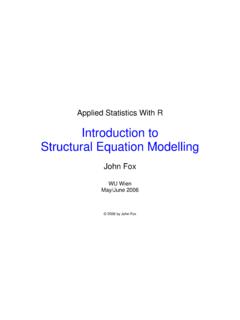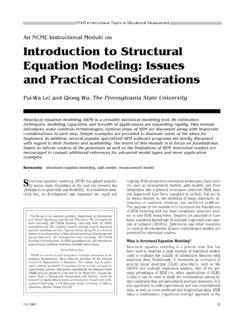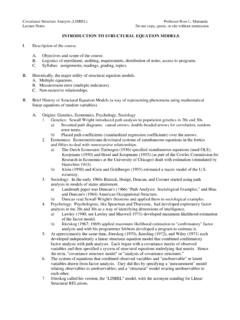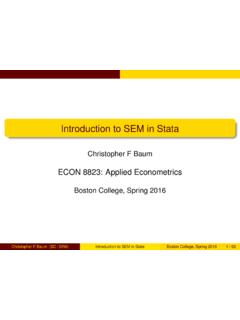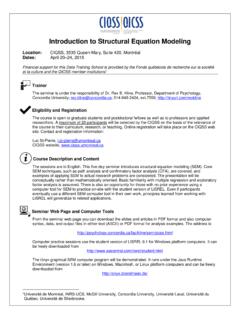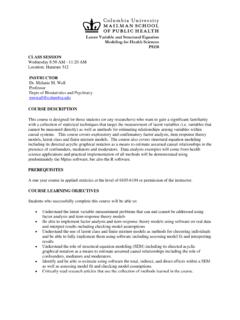Transcription of Introduction to Structural Equation Modeling Using Stata
1 Introduction to Structural Equation Modeling Using Stata Chuck Huber StataCorp California Association for Instituional Research November 19, 2014 Outline Introduction to Stata What is Structural Equation Modeling ? Structural Equation Modeling in Stata Continuous outcome models Using sem Multilevel generalized models Using gsem Demonstrations and Questions Introduction to Stata The Stata interface The menus and dialog boxes Stata command syntax The data editor The do-file editor The Stata Interface The Menus and Dialog Boxes The Data Editor The Do-File Editor Outline Introduction to Stata What is Structural Equation Modeling ? Structural Equation Modeling in Stata Continuous outcome models Using sem Multilevel generalized models Using gsem What is Structural Equation Modeling ? Brief history Path diagrams Key concepts, jargon and assumptions Assessing model fit The process of SEM Brief History of SEM Factor analysis had its roots in psychology.
2 Charles Spearman (1904) is credited with developing the common factor model. He proposed that correlations between tests of mental abilities could be explained by a common factor representing ability. In the 1930s, L. L. Thurston, who was also active in psychometrics, presented work on multiple factor models. He disagreed with the idea of a one general intelligence factor underlying all test scores. He also used an oblique rotation, allowing the factors to be correlated. In 1956, Anderson and H. Rubin discussed testing in factor analysis, and J reskog (1969) introduced confirmatory factor analysis and estimation via maximum likelihood estimation, allowing for testing of hypothesis about the number of factors and how they relate to observed variables. Brief History of SEM Path analysis and systems of simultaneous equations developed in genetics, econometrics, and later sociology. Sewall Wright, a geneticist, is credited with developing path analysis.
3 His first paper Using this method was published in 1918 where he looked at genetic causes related to bone sizes in rabbits. Rather than estimating only the correlation between variables, he created path diagrams to that showed presumed causal paths between variables. He compared what the correlations should be if the variables had the presumed relationships to the observed correlations to evaluate his assumptions. In the 1930s, 1940s, and 1950s, many economists including Haavelmo (1943) and Koopmans (1945) worked with systems of simultaneous equations . Economists also introduced a variety of estimation methods and investigated identification issues. In the 1960, sociologists including Blalock and Duncan applied path analysis to their research. Brief History of SEM In the early 1970s, these two methods merged. Hauser and Goldberger (1971) worked on including unobservables into path models. J reskog (1973) developed a general model for fitting systems of linear equations and for including latent variables.
4 He also developed the methodology for fitting these models Using maximum likelihood estimation and created the program LISREL. Keesling (1972) and Wiley (1973) also worked with the general framework combining the two methods. Much work has been done since then in to extend these models, to evaluate identification, to test model fit, and more. What is Structural Equation Modeling ? Structural Equation Modeling encompasses a broad array of models from linear regression to measurement models to simultaneous equations . Structural Equation Modeling is not just an estimation method for a particular model. Structural Equation Modeling is a way of thinking, a way of writing, and a way of estimating. - Stata SEM Manual, pg 2 What is Structural Equation Modeling ? SEM is a class of statistical techniques that allows us to test hypotheses about relationships among variables. SEM may also be referred to as Analysis of Covariance Structures. SEM fits models Using the observed covariances and, possibly, means.
5 SEM encompasses other statistical methods such as correlation, linear regression, and factor analysis. SEM is a multivariate technique that allows us to estimate a system of equations . Variables in these equations may be measured with error. There may be variables in the model that cannot be measured directly. Structural Equation Models are often drawn as Path Diagrams: Jargon Observed and Latent variables Paths and Covariance Endogenous and Exogenous variables Recursive and Nonrecursive models Observed and Latent Variables Observed variables are variables that are included in our dataset. They are represented by rectangles. The variables x1, x2, x3 and x4 are observed variables in this path diagram. Latent variables are unobserved variables that we wish we had observed. They can be thought of as a composite score of other variables. They are represented by ovals. The variable X is a latent variable in this path diagram. Paths and Covariance Paths are direct relationships between variables.
6 Estimated path coefficients are analogous to regression coefficients. They are represented by straight arrows. Covariance specify that two latent variables or error terms covary. They are represented by curved arrows. Exogenous and Endogenous Variables Exogenous variables are determined outside the system of equations . There are no paths pointing to it. The variables price, foreign, displacement and length are exogenous. Endogenous variables are determined by the system of equations . At least one path points to it. The variables weight and mpg are endogenous. Observed Exogenous: a variable in a dataset that is treated as exogenous in the model Latent Exogenous: an unobserved variable that is treated as exogenous in the model. Observed Endogenous: a variable in a dataset that is treated as endogenous in the model Latent Endogenous: an unobserved variable that is treated as endogenous in the model. Recursive and Nonrecursive Systems Recursive models do not have any feedback loops or correlated errors.
7 Nonrecursive models have feedback loops or correlated errors. These models have paths in both directions between one or more pairs of endogenous variables Notation Observed endogenous: y Observed exogenous: x Latent endogenous: Latent exogenous: Error of observed endogenous: Error of latent endogenous: e. All endogenous: Y = y All exogenous: X = x All error: = e. = + + + We estimate: The coefficients B and The intercepts, The means of the exogenous variables = ( ) The variances and covariances of the exogenous variables, = ( ) The variances and covariances of the errors = ( ) Assumptions Large Sample Size Multivariate Normality Correct Model Specification Assumptions Large Sample Size ML estimation relies on asymptotics, and large sample sizes are needed to obtain reliable parameter estimates. Different suggestions regarding appropriate sample size have been given by different authors. A common rule of thumb is to have a sample size of more than 200, although sometimes 100 is seen as adequate.
8 Other authors propose sample sizes relative to the number of parameters being estimated. Ratios of observations to free parameters from 5:1 up to 20:1 have been proposed. Assumptions Multivariate Normality The likelihood that is maximized when fitting Structural Equation models Using ML is derived under the assumption that the observed variables follow a multivariate normal distribution. The assumption of multivariate normality can often be relaxed, particularly for exogenous variables. Assumptions Correct Model Specification SEM assumes that no relevant variables are omitted from any Equation in the model. Omitted variable bias can arise in linear regression if an independent variable is omitted from the model and the omitted variable is correlated with other independent variables. When fitting Structural Equation models with ML and all equations are fit jointly, errors can occur in equations other than the one with the omitted variable.
9 What is Structural Equation Modeling ? Brief history Path diagrams Key concepts, jargon and assumptions Assessing model fit The process of SEM Assessing Model Goodness of Fit Model Definitions The Saturated Model assumes that all variables are correlated. The Baseline Model assumes that no variables are correlated (except for exogenous variables when endogenous variables are present). The Specified Model is the model that we fit Likelihood Ratio 2 (baseline vs saturated models) 2=2 where: is the loglikelihood for the baseline model is the loglikelihood for the saturated model is the loglikelihood for the specified model = = Likelihood Ratio 2 (specified vs saturated models) 2=2 Assessing Model Goodness of Fit Likelihood Ratio Chi-squared Test ( 2) Akaike s Information Criterion (AIC) Swartz s Bayesian Information Criterion (BIC) Coefficient of Determination ( 2) Root Mean Square Error of Approximation (RMSEA) Comparative Fit Index (CFI) Tucker-Lewis Index (TLI) Standardized Root Mean Square Residual (SRMR) See also: Assessing Model Goodness of Fit Likelihood Ratio 2 (baseline vs saturated models) 2=2 Good fit indicated by: p-value > where.
10 Is the loglikelihood for the saturated model is the loglikelihood for the specified model = Assessing Model Goodness of Fit Akaike s Information Criterion (AIC) AIC= 2 +2 Good fit indicated by: Used for comparing two models Smaller (in absolute value) is better Swartz s Bayesian Information Criterion (BIC) BIC= 2 + Assessing Model Goodness of Fit Coefficient of Determination ( 2) 2=1 Good fit indicated by: Values closer to 1 indicate good fit Assessing Model Goodness of Fit Root Mean Square Error of Approximation Compares the current model with the saturated model The null hypothesis is that the model fits = 2 1 Good fit indicated by: Hu and Bentler (1999): RMSEA < Browne and Cudeck (1993) Good Fit (RMSEA < ) Adequate Fit (RMSEA between and ) Poor Fit (RMSEA > ) P-value > Assessing Model Goodness of Fit Comparative Fit Index (CFI) Compares the current model with the baseline model =1 2 2 Good fit indicated by: CFI > (sometimes ) Assessing Model Goodness of Fit Tucker-Lewis Index (TLI) Compares the current model with the baseline model =1 2 2 2 1 Good fit indicated by: TLI > Assessing Model Goodness of Fit Standardized Root Mean Square Residual (SRMR) SRMR is a measure of the average difference between the observed and model implied correlations.
